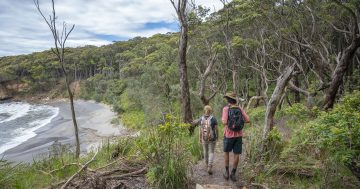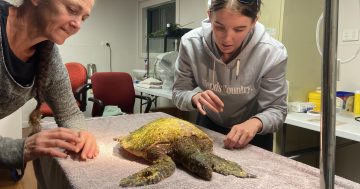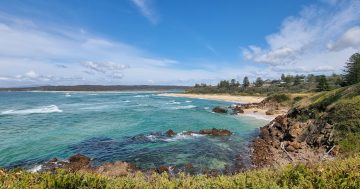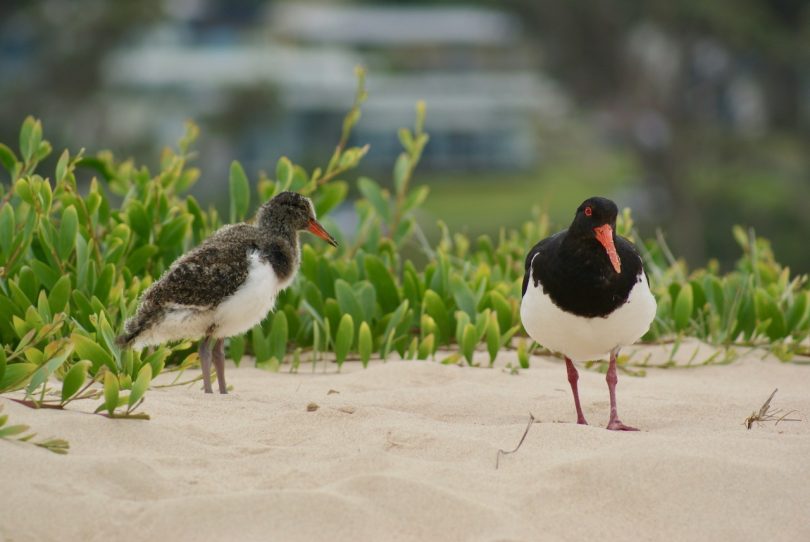
A pied oystercatcher parent and chick at Durras Lake. Photo: Phil MacDonnell.
Your South Coast summer holidays may be over, but there’s still lots of action on the local beaches.
Endangered beach-nesting birds are breeding on South Coast beaches and estuaries from late August through to April. These birds – the hooded plover, pied oyster catcher and little tern – are little known but much loved.
Their home is prime coastal real estate, from the sand dunes to the shoreline. Every summer the beach-nesting birds battle it out with beachgoers to find a top spot on the beach, lay their eggs in the sand and raise their chicks.
As the beaches become busier, the birds become more endangered. Luckily, the National Parks and Wildlife Service, along with a team of more than 100 volunteers, is helping to save the birds.
The South Coast Shorebird Recovery Program (Saving Our Species, NSW Government) starts its call to action every August, when the critically endangered hooded plovers start nesting. There are only an estimated 70 hooded plovers left on the South Coast from Jervis Bay to Eden.
The “hoodies” story is an epic struggle against the odds as they cope with extreme weather events, increasing predation by foxes and ravens, and nest disturbance by people, dogs and vehicles.
Part of the South Coast Shorebird Recovery Program is a travelling summer education program which visits the beaches, and the Holiday Haven caravan parks, between Gerroa and Durras.
Visitors and locals love to learn a bit about the wild South Coast. Bringing people into the shorebird story, letting them know about the birds and why they’re so special, is one of the ways that the birds can be helped.
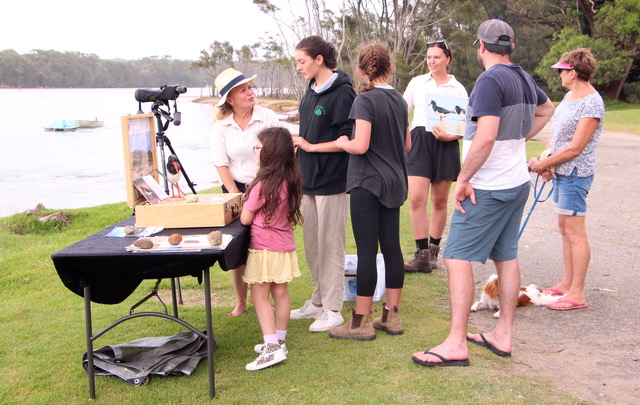
Shorebird education on location at Durras Lake. Photo: Len Glasser.
The chances of survival for beach-nesting birds each year is a lottery, but people can make a difference to the odds of success.
Often the birds will return to the same site each year, with places like Lake Conjola being a top spot for the little terns, and Narrawallee Spit being a favourite for a few pied oystercatcher pairs and a hoodie family.
Visiting holidaymakers are sometimes lucky enough to be around for the month that the birds are sitting on their eggs, or the month that they’re raising the chicks to fledglings.
One of the fascinating facts about the beach-nesting birds is that the parents share the responsibility of sitting on the nest and raising the chicks. If you’re lucky, you might catch a glimpse of a pied oyster catcher showing its young ones where the beach worms are, or a little tern flying back to the nest with a fish in its mouth for its chicks.
There’s plenty of food on the South Coast for these birds, but they need space to feel safe. By sharing the shoreline with them, the birds can do what they’ve always done, undisturbed and without stress.
In the 22 years that the South Coast Shorebird Recovery Program has been running, there has been some success in raising community awareness about the birds and why they’re endangered. Every spring, shorebird volunteers are patrolling their beaches looking for the birds, putting up signs, fencing off nesting areas and talking to visitors about the birds. These are the things that help the shorebirds.
The success of the shorebirds this summer will soon be revealed. Little terns have begun migrating north; hooded plovers will be moving out of the family home and flying up and down the coast; pied oyster catchers will be staying around their favourite estuary or lake, and continuing to enjoy raising their young for another year or so.
This great wild story is live on our beaches. All you need is a pair of binoculars or a good camera and a love of beach walking to enjoy it. The South Coast Shorebird Recovery website will give you more information about where you can go, and what you need to know.
Anna Jarrett is a shorebird educator, story consultant and teacher. She lives in Long Beach, Batemans Bay, and loves to walk on the beach and headlands, looking for birds.












